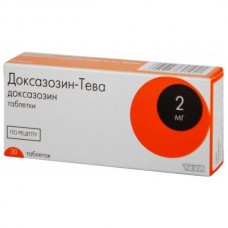Expiration date: 01/2030
pharmachologic effect
Doxazosin - lipid-lowering, antihypertensive, antispasmodic, vasodilator.
Selectively blocks postsynaptic alpha1-adrenergic receptors. By reducing vascular tone muscles reduces peripheral vascular resistance and lowers blood pressure. It reduces the concentration of triglycerides, total cholesterol and HDL cholesterol in the plasma. Simultaneously, there is a slight increase with respect to koeffitsientaLPVP total cholesterol (at 4-13%). Inhibits platelet aggregation and increases the content of active tissue plasminogen. It reduces the tonus of smooth muscle of the stroma and prostate cancer cells capsule and bladder neck. Resistance and lowers the pressure in the urethra, internal sphincter resistance decreases.
pharmacodynamics
After a single dose of the hypotensive effect is achieved in 2-6 hours and lasts for 24 hours. In the period of treatment in hypertensive patients with no differences in blood pressure values ??in the standing and lying down. Long-term treatment is observed regression of left ventricular hypertrophy.
Pharmacokinetics
Well absorbed after oral administration. Absorption - 80-90% (together with food slows absorption by 1 h), Cmax is reached after 3 hours, while taking in the evening after 5 hours Bioavailability -. 60-70% (first pass metabolism). Binding to plasma proteins - about 98%. Rapidly metabolized in the liver by o-demethylation and hydroxylation. Elimination from the plasma takes place in 2 phases, T1 / 2 -. 19-22 hours Provided mainly through the intestine in the form of metabolites, 5% excreted in the urine in unchanged form.
testimony
Arterial hypertension (monotherapy or in combination with other antihypertensive drugs: thiazide diuretics, beta-blockers, calcium channel blockers or ACE inhibitors), benign prostatic hyperplasia (in the presence of hypertension and normal blood pressure).
Contraindications
Hypersensitivity, pregnancy, breast-feeding, age and 18 years of age.
Composition
Active ingredient: 2 or 4 mg doxazosin mesylate
Dosing and Administration
Inside, regardless of meals, without chewing and drinking plenty of water, 1 time a day (morning or evening).
When hypertension: a dose range from 1 to 16 mg / day (maximum); the initial dose - 1 mg 1 time a day (at night), then the patient should be in bed for 6-8 hours (perhaps the phenomenon of "first dose", especially pronounced on the background of the previous diuretics). When insufficient therapeutic effect daily dose increased to only 2 mg 1-2 weeks of continuous treatment, and then at intervals of 1-2 neddozu increased by 2 mg until the optimal therapeutic effect. After reaching a stable therapeutic effect of the dose is usually reduced (the average therapeutic dose for maintenance therapy - 2-4 mg / day).
In benign prostatic hyperplasia without hypertension: usually - 2-4 mg / day, the maximum dose - 8 mg / day.
Side effects
When applying doxazosin, especially at the beginning of treatment, the most frequently observed postural hypotension, which in rare cases can cause fainting. In order to prevent orthostatic hypotension, patients should avoid unexpected and sudden shifts in body position (transition from a lying position to a standing position).
May include the: headache, dizziness, general feeling of weakness, fatigue, drowsiness, rhinitis, nausea. In patients with hypertension rarely observed: tachycardia, arrhythmia, chest pain, angina pectoris, myocardial infarction, cerebrovascular disorders.
There have been isolated cases of allergic reactions (skin rash, jaundice, thrombocytopenic purpura, increased transaminase levels), dry mouth, nosebleeds, priapism, urinary incontinence, increased appetite, constipation, increase diuresis, myalgia, arthralgia.
Drug interactions
It enhances the hypotensive effect of antihypertensive drugs. Compatible with thiazide diuretics, furosemide, beta-blockers, calcium channel blockers, ACE inhibitors, antibiotics, oral hypoglycemic agents, indirect anticoagulants and uricosuric agents. When combined with inducers of microsomal oxidation in the liver may increase the effect of inhibitors - lowering. NSAIDs (especially indomethacin), estrogen and sympathomimetic agents reduce the hypotensive effect. It decreases the pressor effect of ephedrine. Eliminating alpha adrenostimuliruyuschee effects of epinephrine may lead to a distortion of its pressor effect and development of tachycardia.
Overdose
Symptoms: marked reduction of blood pressure, sometimes accompanied by fainting.
Treatment: it is necessary to transfer the patient to a horizontal position (lower her head down, lift the legs), symptomatic therapy.


